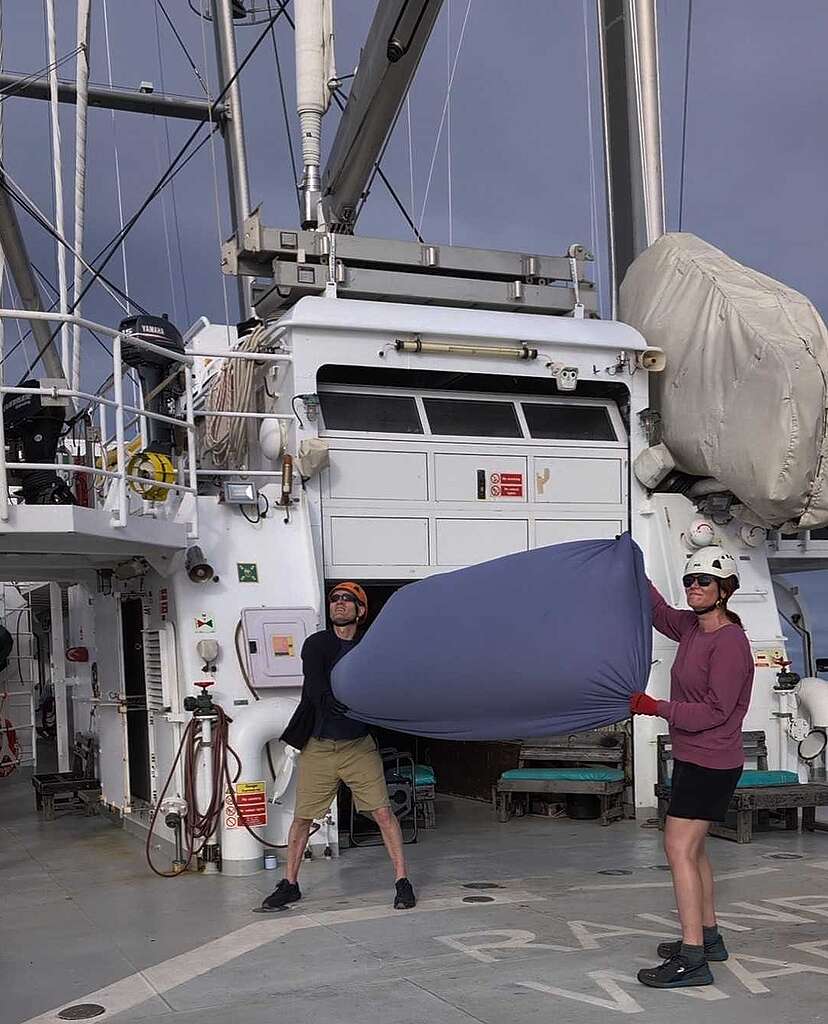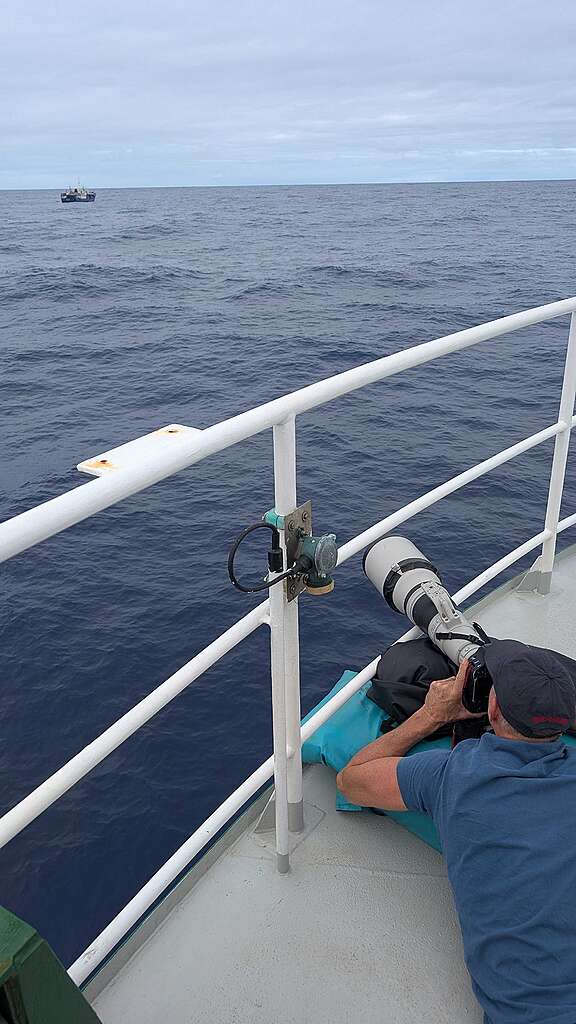Life at sea is at all times unpredictable, and the previous week aboard the Rainbow Warrior has been an ideal reminder of that.
The Greenpeace Australia Pacific group and onboard crew have been navigating via an unusually lengthy stretch of tough climate, with regular swells and heavy rolling with waves averaging three metres. In accordance with the ship’s chief mate, it’s one of many longest intervals of utmost circumstances he’s seen on this vessel — and it’s actually saved everybody on their toes.

Sadly, with the unhealthy climate displaying no indicators of letting up, a few of our plans have needed to be placed on maintain for now. In typical vogue, although, the group has tailored shortly, shifting focus to search out new alternatives. It’s instance of how working at sea means continually adjusting to no matter nature throws your method
Even with the setbacks, there’s been strong progress. The group is at present documenting the operations of a number of worldwide fishing fleets working within the Lord Howe Rise and South Tasman (LoHST) area — a important space for marine safety efforts.
Understanding how these fleets function is a crucial step in demonstrating the necessity for this space to be protected against industrial fishing as a world ocean sanctuary. It’s been horrifiying to see sunfish, rays and sharks introduced up to this point, and equally alarming to see how shut seabirds and whales have come to longlining vessels. This behaviour might point out that seabirds and whales are being drawn in by baited hooks, which places them liable to being caught and by chance hooked, in addition to risking disruption to migration routes and behavior.

One of many main issues in these waters is longline fishing, a way that includes laying out fishing traces that may run for as much as 100 kilometres, lined with hundreds of baited hooks. Whereas longlining is meant to catch species like tuna and swordfish, it additionally captures an enormous variety of non-target species — sharks, turtles, seabirds, and different treasured marine life. The influence on marine ecosystems is critical, particularly on this space the place many species are already underneath strain.
By documenting longline operations, the group helps shine a lightweight on exercise that always goes unnoticed in distant components of the ocean. For now, the Rainbow Warrior and her crew are using out the climate and persevering with to collect info wherever attainable. There’s by no means a uninteresting second out right here, and extra updates will observe because the mission continues.
Life at sea is at all times unpredictable, and the previous week aboard the Rainbow Warrior has been an ideal reminder of that.
The Greenpeace Australia Pacific group and onboard crew have been navigating via an unusually lengthy stretch of tough climate, with regular swells and heavy rolling with waves averaging three metres. In accordance with the ship’s chief mate, it’s one of many longest intervals of utmost circumstances he’s seen on this vessel — and it’s actually saved everybody on their toes.

Sadly, with the unhealthy climate displaying no indicators of letting up, a few of our plans have needed to be placed on maintain for now. In typical vogue, although, the group has tailored shortly, shifting focus to search out new alternatives. It’s instance of how working at sea means continually adjusting to no matter nature throws your method
Even with the setbacks, there’s been strong progress. The group is at present documenting the operations of a number of worldwide fishing fleets working within the Lord Howe Rise and South Tasman (LoHST) area — a important space for marine safety efforts.
Understanding how these fleets function is a crucial step in demonstrating the necessity for this space to be protected against industrial fishing as a world ocean sanctuary. It’s been horrifiying to see sunfish, rays and sharks introduced up to this point, and equally alarming to see how shut seabirds and whales have come to longlining vessels. This behaviour might point out that seabirds and whales are being drawn in by baited hooks, which places them liable to being caught and by chance hooked, in addition to risking disruption to migration routes and behavior.

One of many main issues in these waters is longline fishing, a way that includes laying out fishing traces that may run for as much as 100 kilometres, lined with hundreds of baited hooks. Whereas longlining is meant to catch species like tuna and swordfish, it additionally captures an enormous variety of non-target species — sharks, turtles, seabirds, and different treasured marine life. The influence on marine ecosystems is critical, particularly on this space the place many species are already underneath strain.
By documenting longline operations, the group helps shine a lightweight on exercise that always goes unnoticed in distant components of the ocean. For now, the Rainbow Warrior and her crew are using out the climate and persevering with to collect info wherever attainable. There’s by no means a uninteresting second out right here, and extra updates will observe because the mission continues.
Life at sea is at all times unpredictable, and the previous week aboard the Rainbow Warrior has been an ideal reminder of that.
The Greenpeace Australia Pacific group and onboard crew have been navigating via an unusually lengthy stretch of tough climate, with regular swells and heavy rolling with waves averaging three metres. In accordance with the ship’s chief mate, it’s one of many longest intervals of utmost circumstances he’s seen on this vessel — and it’s actually saved everybody on their toes.

Sadly, with the unhealthy climate displaying no indicators of letting up, a few of our plans have needed to be placed on maintain for now. In typical vogue, although, the group has tailored shortly, shifting focus to search out new alternatives. It’s instance of how working at sea means continually adjusting to no matter nature throws your method
Even with the setbacks, there’s been strong progress. The group is at present documenting the operations of a number of worldwide fishing fleets working within the Lord Howe Rise and South Tasman (LoHST) area — a important space for marine safety efforts.
Understanding how these fleets function is a crucial step in demonstrating the necessity for this space to be protected against industrial fishing as a world ocean sanctuary. It’s been horrifiying to see sunfish, rays and sharks introduced up to this point, and equally alarming to see how shut seabirds and whales have come to longlining vessels. This behaviour might point out that seabirds and whales are being drawn in by baited hooks, which places them liable to being caught and by chance hooked, in addition to risking disruption to migration routes and behavior.

One of many main issues in these waters is longline fishing, a way that includes laying out fishing traces that may run for as much as 100 kilometres, lined with hundreds of baited hooks. Whereas longlining is meant to catch species like tuna and swordfish, it additionally captures an enormous variety of non-target species — sharks, turtles, seabirds, and different treasured marine life. The influence on marine ecosystems is critical, particularly on this space the place many species are already underneath strain.
By documenting longline operations, the group helps shine a lightweight on exercise that always goes unnoticed in distant components of the ocean. For now, the Rainbow Warrior and her crew are using out the climate and persevering with to collect info wherever attainable. There’s by no means a uninteresting second out right here, and extra updates will observe because the mission continues.
Life at sea is at all times unpredictable, and the previous week aboard the Rainbow Warrior has been an ideal reminder of that.
The Greenpeace Australia Pacific group and onboard crew have been navigating via an unusually lengthy stretch of tough climate, with regular swells and heavy rolling with waves averaging three metres. In accordance with the ship’s chief mate, it’s one of many longest intervals of utmost circumstances he’s seen on this vessel — and it’s actually saved everybody on their toes.

Sadly, with the unhealthy climate displaying no indicators of letting up, a few of our plans have needed to be placed on maintain for now. In typical vogue, although, the group has tailored shortly, shifting focus to search out new alternatives. It’s instance of how working at sea means continually adjusting to no matter nature throws your method
Even with the setbacks, there’s been strong progress. The group is at present documenting the operations of a number of worldwide fishing fleets working within the Lord Howe Rise and South Tasman (LoHST) area — a important space for marine safety efforts.
Understanding how these fleets function is a crucial step in demonstrating the necessity for this space to be protected against industrial fishing as a world ocean sanctuary. It’s been horrifiying to see sunfish, rays and sharks introduced up to this point, and equally alarming to see how shut seabirds and whales have come to longlining vessels. This behaviour might point out that seabirds and whales are being drawn in by baited hooks, which places them liable to being caught and by chance hooked, in addition to risking disruption to migration routes and behavior.

One of many main issues in these waters is longline fishing, a way that includes laying out fishing traces that may run for as much as 100 kilometres, lined with hundreds of baited hooks. Whereas longlining is meant to catch species like tuna and swordfish, it additionally captures an enormous variety of non-target species — sharks, turtles, seabirds, and different treasured marine life. The influence on marine ecosystems is critical, particularly on this space the place many species are already underneath strain.
By documenting longline operations, the group helps shine a lightweight on exercise that always goes unnoticed in distant components of the ocean. For now, the Rainbow Warrior and her crew are using out the climate and persevering with to collect info wherever attainable. There’s by no means a uninteresting second out right here, and extra updates will observe because the mission continues.













